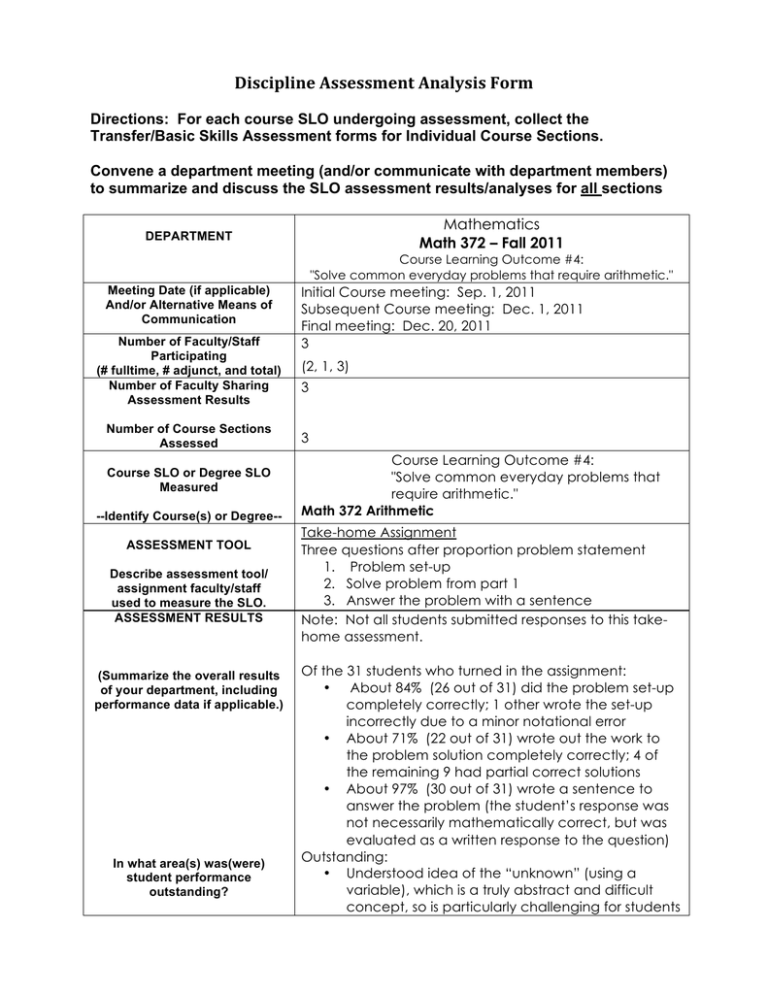Document 12364540
advertisement

Discipline Assessment Analysis Form Directions: For each course SLO undergoing assessment, collect the Transfer/Basic Skills Assessment forms for Individual Course Sections. Convene a department meeting (and/or communicate with department members) to summarize and discuss the SLO assessment results/analyses for all sections Mathematics Math 372 – Fall 2011 DEPARTMENT Course Learning Outcome #4: "Solve common everyday problems that require arithmetic." Meeting Date (if applicable) And/or Alternative Means of Communication Number of Faculty/Staff Participating (# fulltime, # adjunct, and total) Number of Faculty Sharing Assessment Results Initial Course meeting: Sep. 1, 2011 Subsequent Course meeting: Dec. 1, 2011 Final meeting: Dec. 20, 2011 3 (2, 1, 3) 3 Number of Course Sections Assessed 3 Course SLO or Degree SLO Measured Course Learning Outcome #4: "Solve common everyday problems that require arithmetic." Math 372 Arithmetic --Identify Course(s) or Degree-ASSESSMENT TOOL Describe assessment tool/ assignment faculty/staff used to measure the SLO. ASSESSMENT RESULTS (Summarize the overall results of your department, including performance data if applicable.) In what area(s) was(were) student performance outstanding? Take-home Assignment Three questions after proportion problem statement 1. Problem set-up 2. Solve problem from part 1 3. Answer the problem with a sentence Note: Not all students submitted responses to this takehome assessment. Of the 31 students who turned in the assignment: • About 84% (26 out of 31) did the problem set-up completely correctly; 1 other wrote the set-up incorrectly due to a minor notational error • About 71% (22 out of 31) wrote out the work to the problem solution completely correctly; 4 of the remaining 9 had partial correct solutions • About 97% (30 out of 31) wrote a sentence to answer the problem (the student’s response was not necessarily mathematically correct, but was evaluated as a written response to the question) Outstanding: • Understood idea of the “unknown” (using a variable), which is a truly abstract and difficult concept, so is particularly challenging for students at this level Stating the answer to the problem; virtually all students responded correctly Needs improvement: • Symbolic manipulation to arrive at the correct answer Unaddressed student needs or issues revealed: • Large proportion of students we had lost by the time we did the assessment at the end of the term revealed need for more institutional support for these at-risk students throughout the term • In what areas should student performance be improved? Describe unaddressed student needs or issues that the assessment revealed. NEXT STEP(S) TO IMPROVE STUDENT LEARNING How will your department address the needs and issues that were revealed by your assessment? What are your collective plans and strategies for improving student learning? Check all that apply. □ □ □ □ □ □ □ □ □ □ □ Seek out or design faculty development activities on teaching and assessment Consult teaching and learning experts about teaching and assessment methods Encourage faculty to share activities that foster improved student learning Write collaborative grants to fund departmental projects to improve teaching Purchase articles/books on teaching/assessment. Create bibliography of resource material Visit classrooms to provide feedback (mentoring) Share rubrics and assessment results among all discipline faculty Analyze/revise course curriculum and/or SLOs Analyze department curriculum to strengthen the coherence of the program or the progression of skills from course to course Nothing; assessments indicate no improvements necessary Other (please describe): Additional Explanation: The assessment revealed a need for more robust institutional support for these at-risk students throughout the term. More financial support for DSPS is clearly warranted for these basic skills students to succeed. Priorities to Improve Student Learning List the TOP 3 TO 6 actions/changes faculty judge will most improve student learning. IMPLEMENTATION Describe the departmental plans to implement these priorities. TIMELINE FOR IMPLEMENTATION Provide a timeline for implementation of your top priorities. REASSESSMENT When do you plan to reassess this SLO? Continue with assessment Continue with discussion on problem-solving See also above NA NA Fall 2016 – or after course outline update (Course Learning Outcomes are to be modified)


